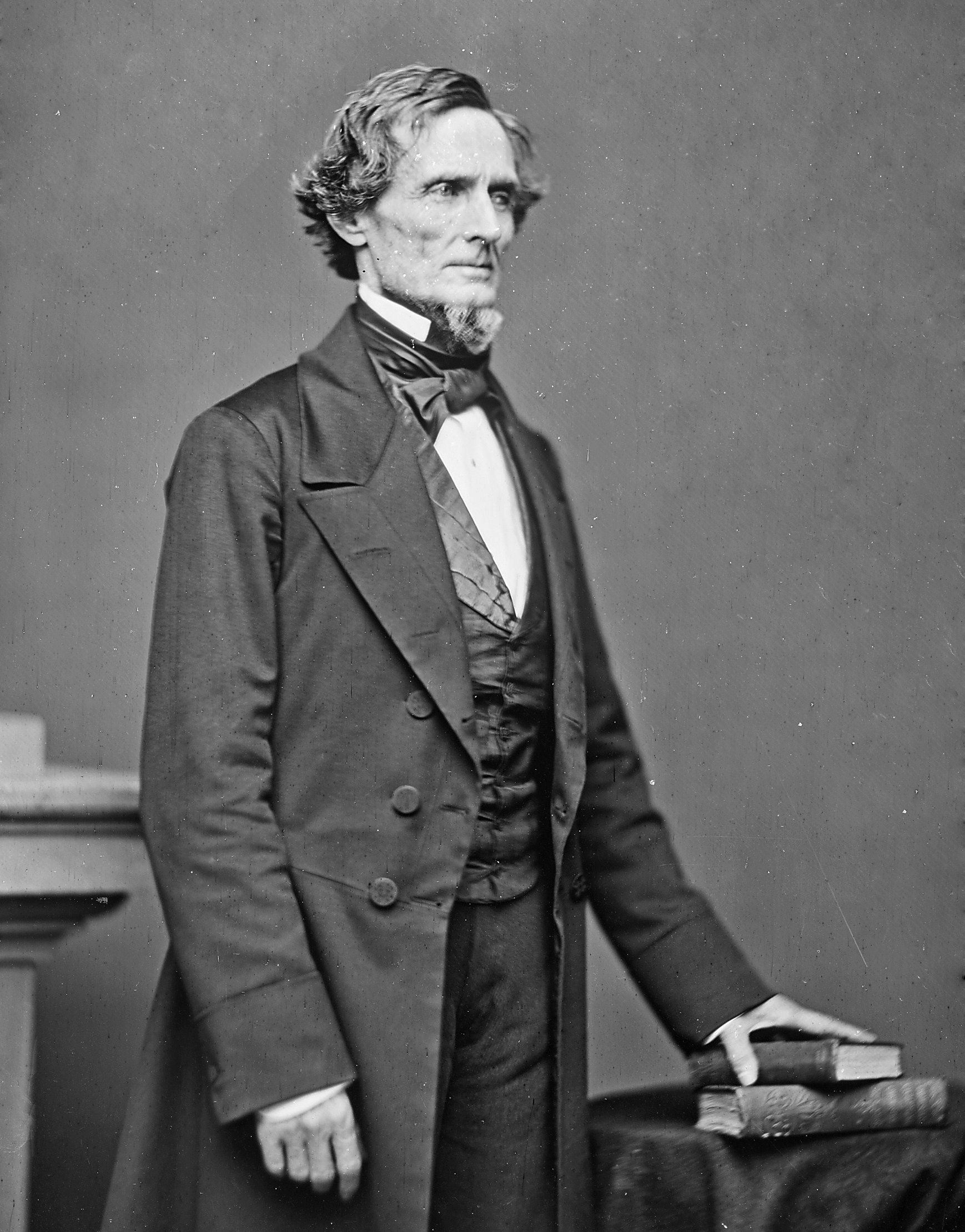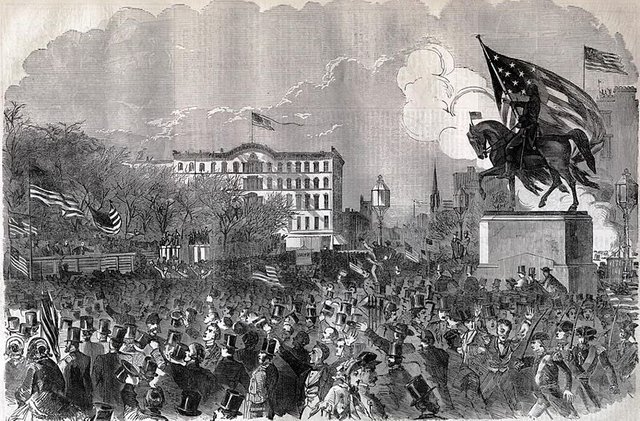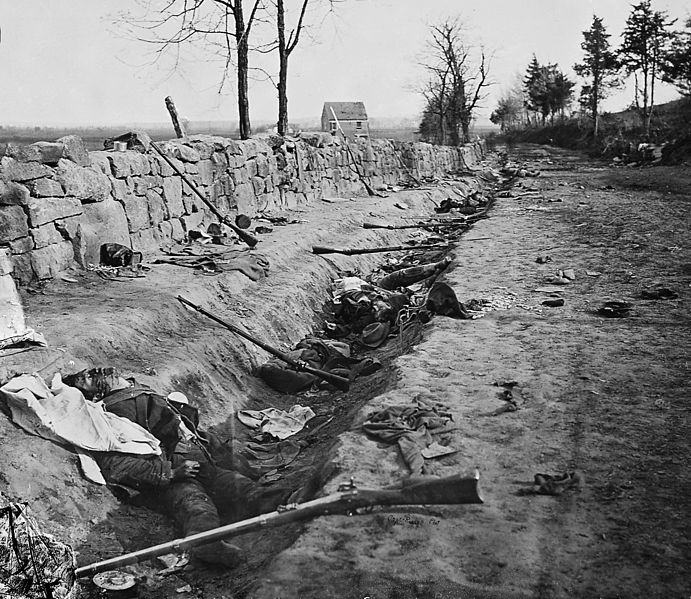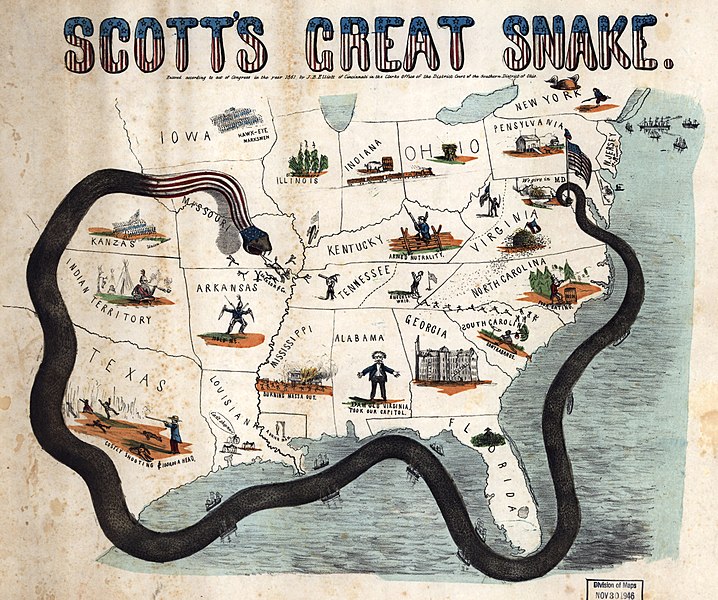History: Rise And Fall Of America: The Civil War Part 3
History: Rise And Fall Of America: The Civil War Part 3
On March 4, 1861, Abraham Lincoln was sworn in as President. In his inaugural address, he argued that the Constitution was a more perfect union than the earlier Articles of Confederation and Perpetual Union, that it was a binding contract, and called any secession "legally void".He had no intent to invade Southern states, nor did he intend to end slavery where it existed, but said that he would use force to maintain possession of Federal property. The government would make no move to recover post offices, and if resisted, mail delivery would end at state lines. Where popular conditions did not allow peaceful enforcement of Federal law, U.S. marshals and judges would be withdrawn. No mention was made of bullion lost from U.S. mints in Louisiana, Georgia, and North Carolina. He stated that it would be U.S. policy to only collect import duties at its ports; there could be no serious injury to the South to justify armed revolution during his administration. His speech closed with a plea for restoration of the bonds of union, famously calling on "the mystic chords of memory" binding the two regions..
The South sent delegations to Washington and offered to pay for the federal properties[which?] and enter into a peace treaty with the United States. Lincoln rejected any negotiations with Confederate agents because he claimed the Confederacy was not a legitimate government, and that making any treaty with it would be tantamount to recognition of it as a sovereign government. Secretary of State William Seward, who at the time saw himself as the real governor or "prime minister" behind the throne of the inexperienced Lincoln, engaged in unauthorized and indirect negotiations that failed. President Lincoln was determined to hold all remaining Union-occupied forts in the Confederacy, Fort Monroe in Virginia, in Florida, Fort Pickens, Fort Jefferson, Fort Taylor and Fort Sumter, located at the cockpit of secession in Charleston, South Carolina..
President-Jefferson-Davis

Battle of Fort Sumter
Fort Sumter was located in the middle of the harbor of Charleston, South Carolina. Its garrison recently moved there to avoid incidents with local militias in the streets of the city. Lincoln told Maj. Anderson to hold on until fired upon. Jefferson Davis ordered the surrender of the fort. Anderson gave a conditional reply that the Confederate government rejected, and Davis ordered General P. G. T. Beauregard to attack the fort before a relief expedition could arrive. He bombarded Fort Sumter on April 12–13, forcing its capitulation.
The attack on Fort Sumter rallied the North to the defense of American nationalism. Historian Allan Nevins said:
The thunderclap of Sumter produced a startling crystallization of Northern sentiment. ... Anger swept the land. From every side came news of mass meetings, speeches, resolutions, tenders of business support, the muster of companies and regiments, the determined action of governors and legislatures."
Union leaders incorrectly assumed that only a minority of Southerners were actually in favor of secession and that there were large numbers of southern Unionists that could be counted on. Had Northerners realized that most Southerners really did favor secession, they might have hesitated at attempting the enormous task of conquering a united South.
Lincoln called on all the states to send forces to recapture the fort and other federal properties. With the scale of the rebellion apparently small so far, Lincoln called for only 75,000 volunteers for 90 days.The governor of Massachusetts had state regiments on trains headed south the next day. In western Missouri, local secessionists seized Liberty Arsenal. On May 3, 1861, Lincoln called for an additional 42,000 volunteers for a period of three years.
Four states in the middle and upper South had repeatedly rejected Confederate overtures, but now Virginia, Tennessee, Arkansas, and North Carolina refused to send forces against their neighbors, declared their secession, and joined the Confederacy. To reward Virginia, the Confederate capital was moved to Richmond.
Great Meeting Union Square

Attitude of the border states
Maryland, Delaware, Missouri, and Kentucky were slave states that were opposed to both secession and coercing the South. West Virginia then joined them as an additional border state after it separated from Virginia and became a state of the Union in 1863.
Maryland's territory surrounded the United States' capital of Washington, DC and could cut it off from the North. It had numerous anti-Lincoln officials who tolerated anti-army rioting in Baltimore and the burning of bridges, both aimed at hindering the passage of troops to the South. Maryland's legislature voted overwhelmingly (53–13) to stay in the Union, but also rejected hostilities with its southern neighbors, voting to close Maryland's rail lines to prevent them from being used for war. Lincoln responded by establishing martial law and unilaterally suspending habeas corpus in Maryland, along with sending in militia units from the North. Lincoln rapidly took control of Maryland and the District of Columbia by seizing many prominent figures, including arresting 1/3 of the members of the Maryland General Assembly on the day it reconvened. All were held without trial, ignoring a ruling by the Chief Justice of the U.S. Supreme Court Roger Taney, a Maryland native, that only Congress (and not the president) could suspend habeas corpus (Ex parte Merryman). Indeed, federal troops imprisoned a prominent Baltimore newspaper editor, Frank Key Howard, Francis Scott Key's grandson, after he criticized Lincoln in an editorial for ignoring the Supreme Court Chief Justice's ruling.
In Missouri, an elected convention on secession voted decisively to remain within the Union. When pro-Confederate Governor Claiborne F. Jackson called out the state militia, it was attacked by federal forces under General Nathaniel Lyon, who chased the governor and the rest of the State Guard to the southwestern corner of the state. In the resulting vacuum, the convention on secession reconvened and took power as the Unionist provisional government of Missouri.
Kentucky did not secede; for a time, it declared itself neutral. When Confederate forces entered the state in September 1861, neutrality ended and the state reaffirmed its Union status, while trying to maintain slavery. During a brief invasion by Confederate forces, Confederate sympathizers organized a secession convention, inaugurated a governor, and gained recognition from the Confederacy. The rebel government soon went into exile and never controlled Kentucky.
After Virginia's secession, a Unionist government in Wheeling asked 48 counties to vote on an ordinance to create a new state on October 24, 1861. A voter turnout of 34 percent approved the statehood bill (96 percent approving). The inclusion of 24 secessionist counties in the state and the ensuing guerrilla war engaged about 40,000 Federal troops for much of the war. Congress admitted West Virginia to the Union on June 20, 1863. West Virginia provided about 20,000–22,000 soldiers to both the Confederacy and the Union.
A Unionist secession attempt occurred in East Tennessee, but was suppressed by the Confederacy, which arrested over 3,000 men suspected of being loyal to the Union. They were held without trial.
War
County map of Civil War battles by theater and year
The Civil War was a contest marked by the ferocity and frequency of battle. Over four years, 237 named battles were fought, as were many more minor actions and skirmishes, which were often characterized by their bitter intensity and high casualties. In his book The American Civil War, John Keegan writes that "The American Civil War was to prove one of the most ferocious wars ever fought". Without geographic objectives, the only target for each side was the enemy's soldier..
Mobilization
As the first seven states began organizing a Confederacy in Montgomery, the entire U.S. army numbered 16,000. However, Northern governors had begun to mobilize their militias. The Confederate Congress authorized the new nation up to 100,000 troops sent by governors as early as February. By May, Jefferson Davis was pushing for 100,000 men under arms for one year or the duration, and that was answered in kind by the U.S. Congress.
In the first year of the war, both sides had far more volunteers than they could effectively train and equip. After the initial enthusiasm faded, reliance on the cohort of young men who came of age every year and wanted to join was not enough. Both sides used a draft law—conscription—as a device to encourage or force volunteering; relatively few were actually drafted and served. The Confederacy passed a draft law in April 1862 for young men aged 18 to 35; overseers of slaves, government officials, and clergymen were exempt. The U.S. Congress followed in July, authorizing a militia draft within a state when it could not meet its quota with volunteers. European immigrants joined the Union Army in large numbers, including 177,000 born in Germany and 144,000 born in Ireland.
When the Emancipation Proclamation went into effect in January 1863, ex-slaves were energetically recruited by the states, and used to meet the state quotas. States and local communities offered higher and higher cash bonuses for white volunteers. Congress tightened the law in March 1863. Men selected in the draft could provide substitutes or, until mid-1864, pay commutation money. Many eligibles pooled their money to cover the cost of anyone drafted. Families used the substitute provision to select which man should go into the army and which should stay home. There was much evasion and overt resistance to the draft, especially in Catholic areas. The great draft riot in New York City in July 1863 involved Irish immigrants who had been signed up as citizens to swell the vote of the city's Democratic political machine, not realizing it made them liable for the draft.Of the 168,649 men procured for the Union through the draft, 117,986 were substitutes, leaving only 50,663 who had their personal services conscripted.
Conf dead chancellorsville

In both the North and South, the draft laws were highly unpopular. In the North, some 120,000 men evaded conscription, many of them fleeing to Canada, and another 280,000 soldiers deserted during the war. At least 100,000 Southerners deserted, or about 10 percent. In the South, many men deserted temporarily to take care of their distressed families, then returned to their units. In the North, "bounty jumpers" enlisted to get the generous bonus, deserted, then went back to a second recruiting station under a different name to sign up again for a second bonus; 141 were caught and executed.
From a tiny frontier force in 1860, the Union and Confederate armies had grown into the "largest and most efficient armies in the world" within a few years. European observers at the time dismissed them as amateur and unprofessional, but British historian John Keegan's assessment is that each outmatched the French, Prussian and Russian armies of the time, and but for the Atlantic, would have threatened any of them with defeat.
Motivation
Perman and Taylor (2010) say that historians are of two minds on why millions of men seemed so eager to fight, suffer and die over four years:
Some historians emphasize that Civil War soldiers were driven by political ideology, holding firm beliefs about the importance of liberty, Union, or state rights, or about the need to protect or to destroy slavery. Others point to less overtly political reasons to fight, such as the defense of one's home and family, or the honor and brotherhood to be preserved when fighting alongside other men. Most historians agree that no matter what a soldier thought about when he went into the war, the experience of combat affected him profoundly and sometimes altered his reasons for continuing the fight
Union soldiers entrenched along the west bank of the Rappahannock River at Fredericksburg, Virginia (111-B-157)
.jpg)
Prisoners
At the start of the civil war, a system of paroles operated. Captives agreed not to fight until they were officially exchanged. Meanwhile, they were held in camps run by their own army where they were paid but not allowed to perform any military duties. The system of exchanges collapsed in 1863 when the Confederacy refused to exchange black prisoners. After that, about 56,000 of the 409,000 POWs died in prisons during the war, accounting for nearly 10 percent of the conflict's fatalities.
Naval war
The small U.S. Navy of 1861 was rapidly enlarged to 6,000 officers and 45,000 men in 1865, with 671 vessels, having a tonnage of 510,396. Its mission was to blockade Confederate ports, take control of the river system, defend against Confederate raiders on the high seas, and be ready for a possible war with the British Royal Navy. Meanwhile, the main riverine war was fought in the West, where a series of major rivers gave access to the Confederate heartland, if the U.S. Navy could take control. In the East, the Navy supplied and moved army forces about, and occasionally shelled Confederate installations.
Union blockade
A cartoon map of the South surrounded by a snake.
General Scott's "Anaconda Plan" 1861. Tightening naval blockade, forcing rebels out of Missouri along the Mississippi River, Kentucky Unionists sit on the fence, idled cotton industry illustrated in Georgia.
By early 1861, General Winfield Scott had devised the Anaconda Plan to win the war with as little bloodshed as possible. Scott argued that a Union blockade of the main ports would weaken the Confederate economy. Lincoln adopted parts of the plan, but he overruled Scott's caution about 90-day volunteers. Public opinion, however, demanded an immediate attack by the army to capture Richmond.
In April 1861, Lincoln announced the Union blockade of all Southern ports; commercial ships could not get insurance and regular traffic ended. The South blundered in embargoing cotton exports in 1861 before the blockade was effective; by the time they realized the mistake, it was too late. "King Cotton" was dead, as the South could export less than 10 percent of its cotton. The blockade shut down the ten Confederate seaports with railheads that moved almost all the cotton, especially New Orleans, Mobile, and Charleston. By June 1861, warships were stationed off the principal Southern ports, and a year later nearly 300 ships were in service.
Scott-anaconda

Modern navy evolves
The Civil War occurred during the early stages of the industrial revolution and subsequently many naval innovations emerged during this time, most notably the advent of the ironclad warship. It began when the Confederacy, knowing they had to meet or match the Union's naval superiority, responded to the Union blockade by building or converting more than 130 vessels, including twenty-six ironclads and floating batteries. Only half of these saw active service. Many were equipped with ram bows, creating "ram fever" among Union squadrons wherever they threatened. But in the face of overwhelming Union superiority and the Union's own ironclad warships, they were unsuccessful.
The Confederacy experimented with a submarine, which did not work well, and with building an ironclad ship, the CSS Virginia, which was based on rebuilding a sunken Union ship, the Merrimack. On its first foray on March 8, 1862, the Virginia inflicted significant damage to the Union's wooden fleet, but the next day the first Union ironclad, the USS Monitor, arrived to challenge it in the Chesapeake Bay. The resulting three hour battle between the Ironclads was a draw, but it marked the worldwide transition to ironclad warships. Not long after the battle the Confederacy was forced to scuttle the Virginia to prevent its capture, while the Union built many copies of the Monitor. Lacking the technology and infrastructure to build effective warships, the Confederacy attempted to obtain warships from Britain.
So That's It For This Part..STay Tuned For Next Part....
don't cry about the rewards being taken away. you are a lazy thief and don't deserve to earn rewards for the work someone else created. If for some reason you don't understand then read this.
Welcome to Steem, @iamnothuman!
I am a bot coded by the SteemPlus team to help you make the best of your experience on the Steem Blockchain!
SteemPlus is a Chrome, Opera and Firefox extension that adds tons of features on Steemit.
It helps you see the real value of your account, who mentionned you, the value of the votes received, a filtered and sorted feed and much more! All of this in a fast and secure way.
To see why 2379 Steemians use SteemPlus, install our extension, read the documentation or the latest release : SteemPlus 2.13: A big refractor to boost performance.
Removing my upvote due to being notified you copied this from wikipedia.
Look at that! A cat wrote this post. Thus the name. I'm really quick with this sort of thing. Glad you found him.
thanks
That is quite the history lesson. I never knew submarines went that far back.
Welcome to Steemit. I found you from the pay it forward feature by
@practicalthought